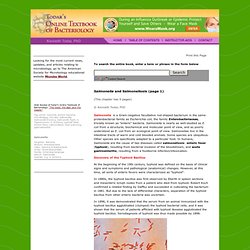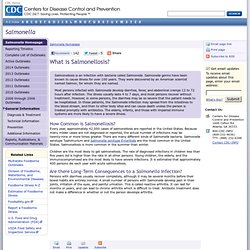

Salmonella and Salmonellosis. To search the entire book, enter a term or phrase in the form below Custom Search Salmonella and Salmonellosis (page 1) (This chapter has 5 pages) © Kenneth Todar, PhD Salmonella is a Gram-negative facultative rod-shaped bacterium in the same proteobacterial family as Escherichia coli, the family Enterobacteriaceae, trivially known as "enteric" bacteria.

Discovery of the Typhoid Bacillus At the beginning of the 19th century, typhoid was defined on the basis of clinical signs and symptoms and pathological (anatomical) changes. In 1880s, the typhoid bacillus was first observed by Eberth in spleen sections and mesenteric lymph nodes from a patient who died from typhoid. In 1896, it was demonstrated that the serum from an animal immunized with the typhoid bacillus agglutinated (clumped) the typhoid bacterial cells, and it was shown that the serum of patients afflicted with typhoid likewise agglutinated the typhoid bacillus. Figure 1. Salmonella Nomenclature chapter continued Next Page. Salmonella. Salmonella /ˌsælməˈnɛlə/ is a genus of rod-shaped, Gram-negative bacteria.

There are only two species of Salmonella, Salmonella bongori and Salmonella enterica, of which there are around six subspecies and innumerable serovars. The genus belongs to the same family as Escherichia, which includes the species E.coli. Salmonellae are found worldwide in both cold-blooded and warm-blooded animals, and in the environment. They cause illnesses such as typhoid fever, paratyphoid fever, and food poisoning.[1] Features[edit] Salmonella are non-spore-forming, predominantly motile enterobacteria with diameters around 0.8 to 1.5 µm, lengths from 2 to 5 µm, and peritrichous flagella, (flagella that are all around the cell body).
History[edit] The genus Salmonella was named after Daniel Elmer Salmon, an American veterinary pathologist. Detection, culture and growth conditions[edit] Salmonella nomenclature[edit] Salmonella as pathogens[edit] Nontyphoidal Salmonella[edit] Typhoidal Salmonella[edit] Salmonella nomenclature. The phs gene and hydrogen sulfide production by Salmonella typhimurium. General Information on Salmonella. Salmonellosis is an infection with bacteria called Salmonella.

Salmonella germs have been known to cause illness for over 100 years. They were discovered by an American scientist named Salmon, for whom they are named. Most persons infected with Salmonella develop diarrhea, fever, and abdominal cramps 12 to 72 hours after infection. The illness usually lasts 4 to 7 days, and most persons recover without treatment. However, in some persons, the diarrhea may be so severe that the patient needs to be hospitalized. How Common is Salmonellosis? Every year, approximately 42,000 cases of salmonellosis are reported in the United States. Children are the most likely to get salmonellosis. Are there Long-Term Consequences to a Salmonella Infection? Persons with diarrhea usually recover completely, although it may be several months before their bowel habits are entirely normal. Typhoid Fever: General Information - NCZVED. Frequently Asked Questions Typhoid fever is a life-threatening illness caused by the bacterium Salmonella Typhi.

In the United States, it is estimated that approximately 5,700 cases occur annually. Most cases (up to 75%) are acquired while traveling internationally. Typhoid fever is still common in the developing world, where it affects about 21.5 million persons each year. Typhoid fever can be prevented and can usually be treated with antibiotics.
How is typhoid fever spread? Salmonella Typhi lives only in humans. You can get typhoid fever if you eat food or drink beverages that have been handled by a person who is shedding Salmonella Typhi or if sewage contaminated with Salmonella Typhi bacteria gets into the water you use for drinking or washing food. Once Salmonella Typhi bacteria are eaten or drunk, they multiply and spread into the bloodstream. Where in the world do you get typhoid fever? How can you avoid typhoid fever? Two basic actions can protect you from typhoid fever: